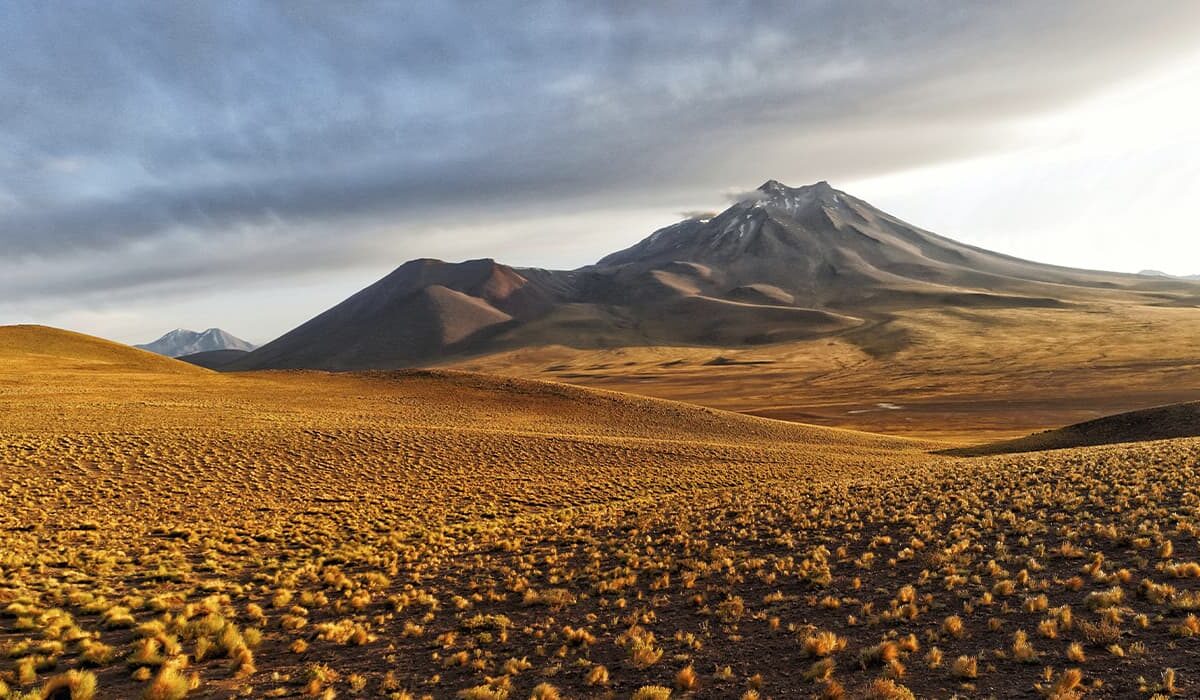Strange as it may sound, one of the driest places on the planet is located on the wettest continent. The Atacama Desert (Desierto de Atacama) is a lifeless wasteland that stretches in northern Chile between the Andes and the Pacific coast. Sometimes there are no animals or plants for many kilometers. It rains so rarely in the Atacama that in some regions it hasn’t rained in several hundred years. The landscape is enlivened only by the intricate dances of small tornadoes that dance here and there on the sand and rocks.
Features of the Atacama
The Atacama Desert in South America is considered one of the oldest on the planet. Evidence indicates that it was formed at least 20 million years ago. The desert stretches from the Chile-Peru border for 1,000 km along the ocean and covers about 105,000 km².
The Atacama Desert looks very different from what we are used to seeing in pictures. It is more often absolutely lifeless stony areas, because the desert is part of the Andes. The coastal areas are sometimes several hundred meters above sea level.
Why is Atacama the driest desert?
A desert is an area with annual precipitation not exceeding 250 mm, in Atacama it falls 25 times less. Another difference between the Chilean desert and other arid regions of the planet is that it is the coldest in the world. The average daily air temperature during the year here ranges from 0-25 ° C. It’s relatively hot during the day and sometimes freezing at night.
The blame for Atacama’s drought lies in the high mountains and the cold Pacific Current. It would seem that the ocean, on the contrary, should more than saturate the coastal areas with rain, but not in the case of Atacama. The cold Humboldt Current passes through here, so water temperatures off the northwestern coast of Chile are significantly cooler than usual in these latitudes. By crossing the current, the sea wind cools, dries out, and reaches the mainland without a drop of moisture.
On the other hand, the rains could come from the east, but here, too, the “rain shadow” phenomenon is a problem. The clouds with their accumulated moisture can’t get over the high mountains, so all the rain falls on the eastern slopes of the Andes, never irrigating the Atacama.
Life in the Desert
Chileans are not intimidated by the dryness of the Atacama. It is home to more than a million Atacamenos, the name of the indigenous people. They are the descendants of the ancient Indians, who mostly live in coastal towns, mining and fishing villages.
Locals pump water from underground springs wherever possible. Using modern irrigation techniques, they manage to grow vegetables and fruits even on arid soils. In addition, atacamenos extract moisture from the thick fogs called kamanchaka with the help of special foggers.
What to see in the Atacama Desert
The Atacama occupies a huge area. Tourist attractions are scattered throughout the desert, so you need to decide on an itinerary in advance. It is most reasonable to tour from the cities of Antofagasta, San Pedro de Atacama, Calama, Arika or Iquique. The desert has a well-developed road network.
San Pedro de Atacama is the main tourist center of the desert. Here you can stay overnight and eat, buy a tour, and rent a car. There’s not much to see in the town itself, except for the main attraction, the church of San Pedro, which was built in the 17th century. In the northern part of the city is the pre-Columbian village of Pucara de Quitor. It is famous for its fortress of the XII century.
In relative proximity to San Pedro is the oldest human settlement in Chile, Tulor. This archaeological site is the ruins of round adobe buildings several thousand years old.
The picturesque area known as Lunar Valley, 15 km west of the city, is one of the driest places on the planet. In some of its areas there has been no rain for hundreds of years. The scenery and conditions match those of Mars, so explorers of the red planet use the valley as a testing ground.
From San Pedro there is a road to the world’s third largest salt marsh, the Salar de Atacama, whose fabulous ethereal vistas are stunningly beautiful. Flocks of flamingos grazing near the shores of the salt lagoons complete the range of colors. The most famous among them is the Sekhar Lagoon. The concentration of salt in its water is so great that the human body pushes to the surface. Among the salt lagoons, there are two unique reservoirs of fresh water, they are called Oko de Sekhar.
Because of the lack of rain in the Atacama Desert, ancient geoglyphs – giant drawings on the surface of the ground – are well preserved. Scientists believe that they were painted by caravan drivers, to mark the routes. The most massive collection of such images is Serros Pintados, there are more than 350 of them. In Atacama they also found the largest geoglyph in the world, it is called Tarapaka or Giant of the Atacama Desert. The figure is almost 90 meters long. It can be fully seen only from a bird’s-eye view.

